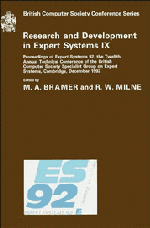Book contents
- Frontmatter
- Contents
- Preface
- Introduction
- CONSULTANT: providing advice for the machine learning toolbox
- A methods model for the integration of KBS and conventional information technology
- KBS methodology as a framework for co-operative working
- Project management for the evolutionary development of expert systems
- The specification and development of rule-based expert systems
- Towards a method for multi-agent system design
- Jigsaw: configuring knowledge acquisition tools
- On the relationship between repertory grid and term subsumption knowledge structures: theory practice tools
- Strategy maze: an on-line tool for support management of the knowledge acquisition process
- Concurrent engineering using collaborating truth maintenance systems
- Ockham's razor as a gardening tool
- A designer's consultant
- Fairness of attribute selection in probabilistic induction
- An application of case-based expert system technology to dynamic job-shop scheduling
- Neural network design via LP
- KEshell2: an intelligent learning data base system
- Approaches to self-explanation and system visibility in the context of application tasks
- An object oriented approach to distributed problem solving
- Intelligent user interface for multiple application systems
- Combining qualitative and quantitative information for temporal reasoning
- Documents as expert systems
Towards a method for multi-agent system design
Published online by Cambridge University Press: 04 August 2010
- Frontmatter
- Contents
- Preface
- Introduction
- CONSULTANT: providing advice for the machine learning toolbox
- A methods model for the integration of KBS and conventional information technology
- KBS methodology as a framework for co-operative working
- Project management for the evolutionary development of expert systems
- The specification and development of rule-based expert systems
- Towards a method for multi-agent system design
- Jigsaw: configuring knowledge acquisition tools
- On the relationship between repertory grid and term subsumption knowledge structures: theory practice tools
- Strategy maze: an on-line tool for support management of the knowledge acquisition process
- Concurrent engineering using collaborating truth maintenance systems
- Ockham's razor as a gardening tool
- A designer's consultant
- Fairness of attribute selection in probabilistic induction
- An application of case-based expert system technology to dynamic job-shop scheduling
- Neural network design via LP
- KEshell2: an intelligent learning data base system
- Approaches to self-explanation and system visibility in the context of application tasks
- An object oriented approach to distributed problem solving
- Intelligent user interface for multiple application systems
- Combining qualitative and quantitative information for temporal reasoning
- Documents as expert systems
Summary
Abstract
We describe a method for Multi-Agent System design which is assisted by two original typologies, resulting from the deeper study of knowledge and reasoning. The first typology reflects a formal character while the second reflects a technological character. The purpose of the Formal Typology is the classification and structuring of knowledge and reasoning. The Technological Typology handles the parameters governing the reasoning intrinsic to Multi-Agent technology, not only at the individual level of the agent but also within a group of agents. Possible correspondence between both of these typologies will become concrete by the presentation of the Multi-Agent generator MAPS (Multi-Agent Problem Solver), and the Multi-Agent system KIDS (Knowledge based Image Diagnosis System) devoted to Biomedical Image Interpretation.
Keywords
Second Generation Expert Systems, Multi-Agent System Design, Distributed Artificial Intelligence, Knowledge and Reasoning Modeling, Control, Biomedical Image Interpretation.
INTRODUCTION
Among knowledge based systems using artificial intelligence techniques we are particularly interested in the Multi-Agent systems which arise from their second generation (systems using multiple reasoning schemes). The Multi-Agent paradigm results from distributed artificial intelligence approaches and makes it possible to overcome the drawbacks encountered during the resolution of complex problems. The main issue of the Multi-Agent approach involves the distribution of tasks and skills among intelligent entities that co-operate, pooling their knowledge and their expertise to attain an aim (Ferber 88). In this way, not only a multi-modal knowledge representation, and reasoning schemes handling are permitted but also, co-operative problem solving.
- Type
- Chapter
- Information
- Research and Development in Expert Systems IX , pp. 93 - 106Publisher: Cambridge University PressPrint publication year: 1993
- 2
- Cited by

